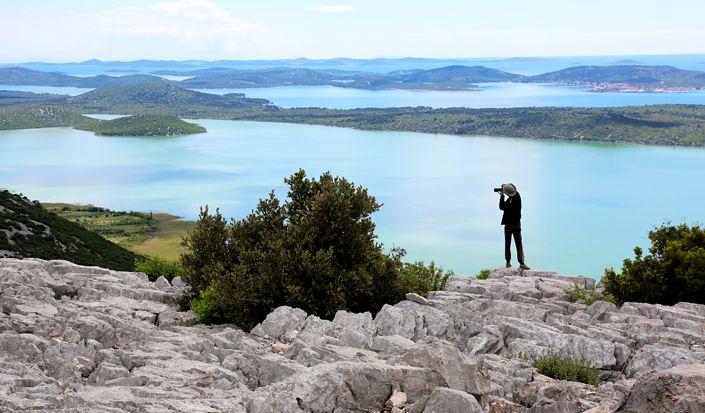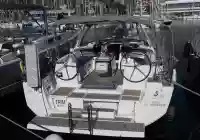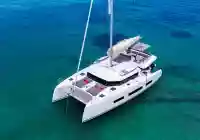Not only does Croatia encompass the glistening Adriatic Sea, with its renowned 1000 islands that I know you sailors love, but there are some special places, not too far from the sea that are really worth exploring. Follow me to Vransko Jezero and once you have experienced its beauty, you will wonder why you haven’t heard of it before.
Vransko Jezero (which literally translated means “Crow's Lake”) or as it's also called in English – Lake Vrana, is Croatia’s largest natural lake. Not only does it offer magnificently beautiful landscapes for the eyes to feast on, but it is a most unique biodiverse area. However, it is believed that its name originated from “Laurana”, which was the old name for what used to be the flooded area of Vransko Polje (Field), which the locals possibly abbreviated to create the name of Vrana Lake. A section of the lake comprises one of the last wetlands in the Eastern part of the Adriatic in Croatia and is a bird-lovers’ paradise. In 1983 it was recognised as a Special Ornithological Reserve and declared a Ramsar site in 2013, i.e. a wetland area of international importance.
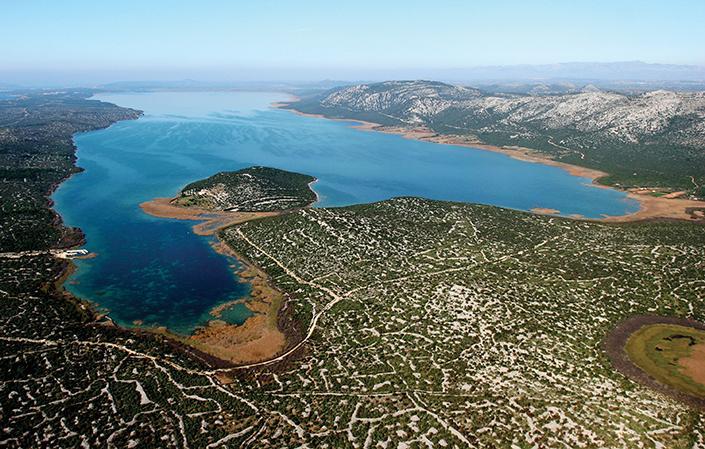
To add to its natural gifts, Vransko Jezero Nature Park also boasts an extremely rich and ancient history with some finds dating all the way back to 2000 years BC. There is on-going research on varying elements from ecological to archaeological that make this place so exceptional. During the autumn migrations the Ornithological Reserve hosts a ringing camp, which gathers a large number of ornithologists, bird lovers and volunteers.
The nature park is situated in a karst valley on the stretch between the coastal towns of Pakoštane and Pirovac in the province of Dalmatia. (Note: Don’t confuse this with the smaller freshwater lake called Vrana on Cres island). The park is sprawled out over an area of 57km2, of which the lake itself fills over 30,02kms2. The bottom of the lake is below sea level and the surface above and this is called cryptodepression.
Pakoštane is the closest town to the lake and a great place to berth your yacht. The locals jokingly call it the small town by the marina! The small port is centrally situated off the town centre’s promenade. It’s flanked by a long pier on one side, on the other side of which are pleasant beaches fringed by pines and conifers. The port is sheltered from winds by the Kornati islands, with St Juština, Školj and Babuljaš, being the three closest islets. They create a captivating backdrop to the setting of this charming town.
The port has water and electricity supply, but the nearest boating fuel station is at Biograd Na Moru – some 4 Kms in a north-westerly direction. It also has a boat lifting crane and a dry dock for servicing of boats and winter storage.
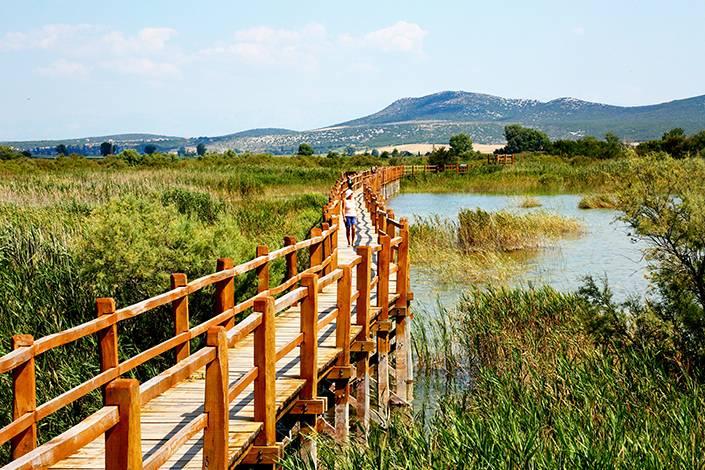
The lake is separated from the sea only by a narrow karst ridge of between 0.8 and 2.5 kms wide. If you would like to just visit the Ornithological Reserve, you can simply take a walk to the lake. It’s only 2 km from the port to the Crkvine entrance and then a mere 200 m to the reserve.
However, I would like to show you the full experience of the entire Vransko Jezero Nature Park with many more of its numerous and splendid offerings. For this, you will need to rent a car in Pakoštane and do a self-drive, enjoying the journey in your own time. Let’s set out as early as possible. Wear good walking shoes, make sure you’ve got enough water (there are shops available later) and of course a hat and sunscreen. An added bonus would be binoculars, so bring those too. Let’s enjoy this impressive lake in its hues of greenish-blue, which runs alongside and parallels the cobalt blue Adriatic sea.
Just before the main entrance, Crkvine, you will find the remains of St. Mary’s church with 75 graves of Templar Knights. Then drive in through the entrance where you pay a fee of 20 Kn pp (3 Euros), 10 Kn (1,5 Euros) per child 7 to 18 years, and children under 7 are free. There is also a family fee of 50 Kn (7 Euros) and students and retirees pay 15,00 Kn (2 Euros) (provided they produce student cards or IDs for proof). You can also hire binoculars at the info centre if you don’t have. Nearby on the shores of the lake, there is a well-established private campsite… but let’s move on.
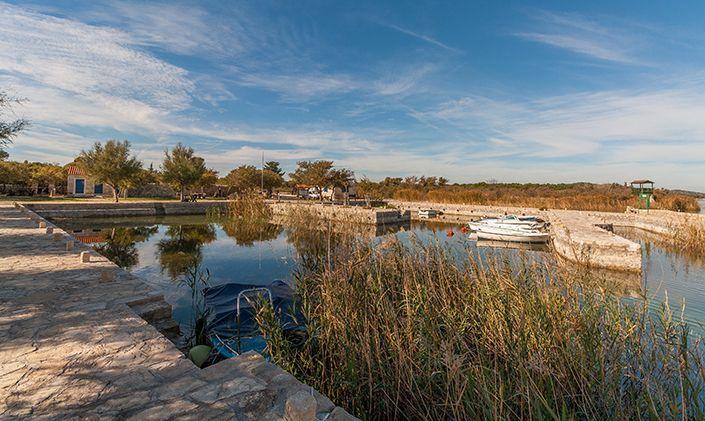
Crkvine is one of three info centres around the lake with about 15 kms distance between each of them. Most of the roads are tarmacked, but some sections are dirt roads, which have recently been upgraded. Beside each info centre you can park your car and take a walk to immerse yourself fully in the serenity and beauty of Lake Vrana. For sporty types, the park has hiking trails and bicycle routes totalling a distance of more than 50 kms.
Most interesting, without doubt, would be to spend some time in the Ornithological Reserve so how about we first head there? There is a 600 m long educational trail. You will see signboards along the way, which are interestingly informative. Go quietly as you walk along the wooden boardwalk so you don’t frighten the birds away.
The different colours, shapes and sizes of the multitude of birds that have their homes right here are astounding! It is said that over 100,000 waterbirds winter in this area . More than 260 species have been identified with 120 species nesting during spring and summer. Some birds stay in the lake area all year round, while the others visit the park seasonally, using it as a resting place for their long flights to the south just before winter, or in spring when they’re northward bound.
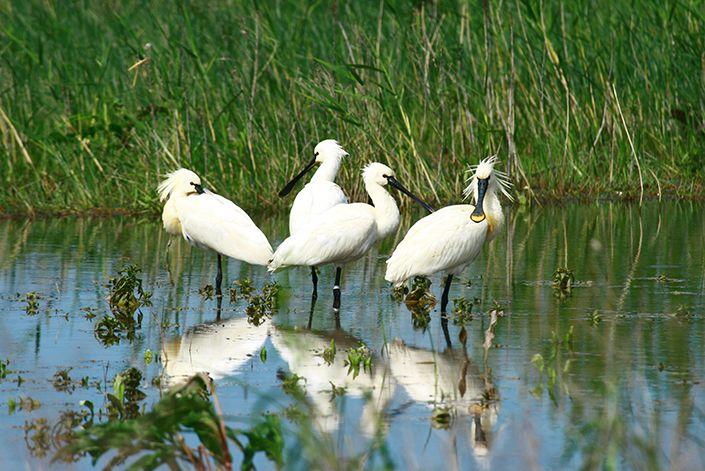
A good idea would be to head to one of the bird watchtowers where we can spend some time and … Hush! ever so quietly… observe the hustle and bustle of birds going about their daily business - building their nests in the reeds, feeding their young, floating on the water and flying in and out of their watery domain. Flowers in spring attract a magnificent amount of butterflies, dragonflies and many insects. A feasting ground for the birds.
A feasting ground for the birds.
You may see a Great White Egret or a Heron swooping down to catch a fish. For the Purple Heron, the lake is the only stable nesting ground along the Croatian coast.
Simply soak in the aromas of reeds, rushes and sedge brush and sink into the serenity, broken only by the continuous music of a myriad bird chirps and calls, and the ribbits and croaks of frogs and toads – a symphony to the senses.
Amongst the green marshy plants and long tall reeds, you are more than likely to see the small brown fishermen, the Pygmy Cormorants who have their only stable breeding population here.. This aquatic paradise has protected four bird species that are endangered in Europe, another seven that are on the endangered list for Croatia and also provides a safe haven for a vast variety of creatures.
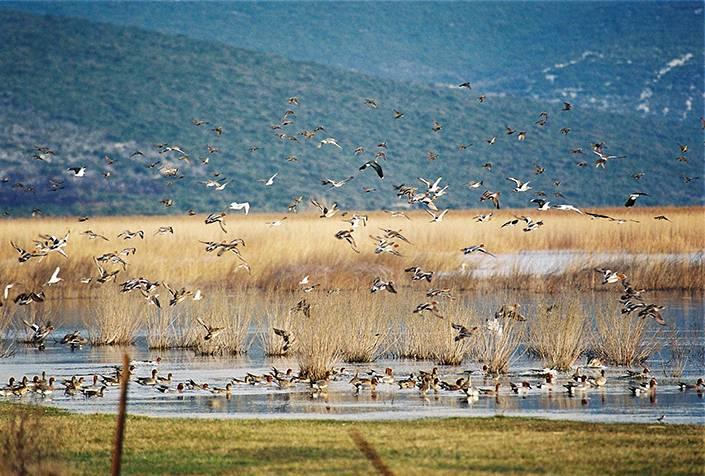
Once back in the car, let’s drive around to Vrana. This small, historic and ancient town bears the remains of a medieval fortress, Gradina, which was destroyed in the 17th Century and houses what’s left of the Gothic church of St Catherine. Allow yourself to be transported back to the time when Vrana formed the north-western corner of the Ottoman Empire. It’s cultural heritage is rich with stories of battles, divergent rulers and inhabitants from the Benedictines, the Templars, the Knights of Ivanovci, to the Venetians and ultimately the Turks.
A local peasant Yusuf Mašković, became a Turkish Fleet Commander and advisor, and in 1644 started constructing Mašković Khan as a hostel for travellers and a summer home for himself where he could ultimately retire. Before it was completed, he was executed on the Sultan’s orders for being merciful to Venetian prisoners. Recently a grant from the EU has enabled this noble building, which is the largest building of Turkish architecture in Croatia, to be completed. It now provides accommodation with a souvenir shop, restaurant, museum and wellness centre. Every summer the Khan has staged the event, the “Days of Vrana Knights”.
The Pećina Cave, a short hike away, is fabled to be the Roman “sanctuary of nymphs”. It has a freshwater spring that was the source of an aqueduct, which supplied Zadar and all the surrounding areas. The spring dries up in summer until it revives during the first autumn rains.
Next on the agenda is the highlight of the area – the summit of the hill, Kamenjak. Stroll through the wondrous lookout point, take a peek at the traditionally built stone info center and the tiny All Saints Chapel next to it. The info boards describe a little bit of the background on this locality that’s older than 2000 years.
The view from there is amazing, but better still, let’s take a walk up a rocky outcrop to the northern viewpoint and you will be blown away by the spectacular panorama in front of your eyes. Not only will you get a bird’s eye view of the entire expanse of the lake below, but also the coastline with the towns of Murter, Tisno, Drage, Pirovac and Pakoštane scattered along it, the deep blue sea of the Zadar Archipelago strewn with the Kornati Islands … and beyond … to infinity. Simply sublime!

Then a short walk to check out the southern lookout – again the aquamarine colours of the still lake and the deep blue sea beyond the isthmus of land separating them. Keep your eyes peeled for raptors as they glide on the air currents above you. Both viewpoints have panoramic telescopes if you need a closer look. Perhaps, apart from the abundance of avian creatures, you could spot a Hermann’s tortoise or a European Green Lizard. The area provides shelter for many reptiles - snakes and lizards, as well as numerous mammals.
Follow me back to the info centre where you can buy souvenirs, local products and drinks, but more importantly, how about enjoying the local fare with a wine tasting accompanied by cheese, olive oil and prosciutto at the Kamenjak Tavern? You can even sample their homemade brandy. Relax to catch your breath while gazing out at the picturesque scene that leaves you breathless!
On the hiking trail from Kamenjak are the remains of an ancient fort called Osridak built in the 4th Century. This would take about an hour to walk to, so we’ll skip it and head on to the last stop – a 20-minute drive around alongside farmlands and Home Oak forests to the Prosika Info Centre.
Here a seating area is flanked by a row of large info boards. The restrooms are housed in the original 18th century fisherman’s cottage. Stone benches and tables, next to an old well, are sheltered by shady trees and look onto a charming little port on the lake. If you would like to cool off and have a swim in the lake, this would be a good spot for that. Next to the info centre is the Prosika canal, which is the reason that this area has become a marvel of nature and this is how it came about.
In the 18th century the whole area was a large wetland and a canal was constructed by Francesco Borelli, a local landlord, to connect the sea and the lake in the hope of draining some of the marshy area on the Northern end of the lake to combat malaria. There was much resistance to this plan, but ultimately it went ahead. After 18 years, when the canal was opened up, the water level of the lake dropped by three metres. This made it possible to convert the north-western area beyond the Ornithological Reserve, what was once called Vransko Blato (Vrana’s Mud), into lush farmlands. Unfortunately this has also impacted negatively to the overall biological diversity as in dry years an intensive influx of seawater additionally salinizes the lake, which can have catastrophic consequences for freshwater organisms.
At Prosika there is also a natural phenomenon that occurs when the jugo wind blows. Seawater flows from underground into the lake here, which makes it perfect for eels to migrate from the sea to the lake through the crevices in the karstic underground.
From Prosika the lake sweeps away in front of you and if you look across it to the right, you can see Babin Škoj (Grandmother’s Island), which is now in fact a small peninsula until the water levels rise and then it becomes an island again. Tall stone heaps bear testimony to those who inhabited the area in ancient times. The cairns were built over graves in which were found remains of the buried and their possessions. Stone walls, visible around the island, were built by the Illyrians and Romans. The Venetian guardhouse, from which their enemies were bombarded with cannon fire, was built at the beginning of the 16th Century - an era of great unrest, when the boundaries between the Turks’ and Venetians’ territories were drawn up.
Although fishing is possible in all parts of the lake except the Ornithological Reserve, Prosika and Golubinka form the most popular fishing corner of the lake with an abundance of fish available almost all year round. Big 200 kg catches are common, mostly catfish and carp. If you look hard enough, maybe you will even catch a glimpse of the legendary formidable dragon asleep in the lake’s depths!
Then a quick drive to our last stop - the Čelinka viewpoint. Topped with a whimsical stone cottage and the gift of a 360 degree view – farmlands, vineyards and olive groves and the serene lake on one side, and looking down on the town of Drage and the sea on the other. Then back to Pakoštane and civilisation.
Before I go, let me tell about two other great options for yachtsmen to stay over. One is Pirovac - a quaint, small town in a well-protected long bay on the south end of the lake. Their newly constructed marina opened in 2017 with space for 200 boats and all the necessary amenities available to sailors, including boat service and lift, as well as a restaurant within the marina. The marina, together with the revamped beach close by, have given Pirovac a great facelift blending antiquity with modernity.
Secondly, for those who like more activities and life, try Biograd-Na-Moru, a vibrant city 10 NM south of Zadar. It is located at the heart of the Adriatic and was once the Capital City of Croatian Kings. One of its two marinas, the well-organised Marina Kornati is listed as one of the top three marinas in Croatia with a capacity of 854 berths allowing for boats of up to 23 metres. It’s a popular destination for yachtsmen and has annually hosted more than 50 regattas and shows, including the Biograd Boat Show, which is the largest mid-European nautical show. Here you could book an organised tour to Lake Vrana if you preferred.
Whichever one of these port towns you choose, from here you can sail on to explore the 89 islands and reefs of the nautical paradise, Kornati National Park.
As the wildlife and nature connoisseur, Sir David Attenborough, who turned 94 the other day, says: “It seems to me that the natural world is the greatest source of excitement; the greatest source of visual beauty; the greatest source of intellectual interest. It is the greatest source of so much in life that makes life worth living.”
This, I can say, is very true of what we have explored here, one of nature’s marvels - Vransko Jezero.
Photos: Public institution Nature Park Vransko jezero
By Diana Karmela
Powered by

Kralja Petra Svačića 2, 23210 Biograd na Moru
tel: +385 23 383 181
e-mail: info@pp-vransko-jezero.hr

